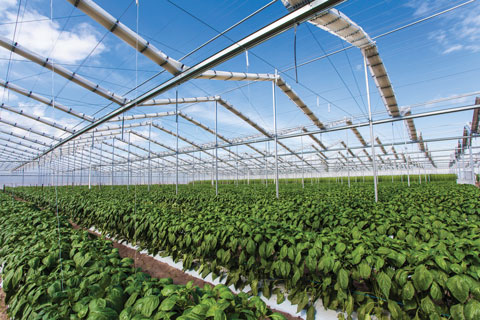6/1/2019
Whatever Happened to Retractable-Roof Greenhouses?
Chris Beytes

I remember my first retractable-roof greenhouse. It was December 1993 and I was visiting poinsettia growers in Texas with GrowerTalks editor Vic Ball. One of our stops was Plants, Inc. in Huntsville, where, in addition to poinsettias, we saw one of Cravo’s first Retract-A-Roof greenhouses under construction.
Operations Manager Clay Murphy told us he wanted fast payback and low energy costs for bedding plants and seasonal crops. In addition, “the crops that we grow like lots of air, especially down here in the South. We wanted to get as much air and light in as we could.” The retractable roof fit the bill.
Pictured: Peppers growing in a Cravo X-Frame retractable-roof house in Australia. Photo courtesy of Cravo.
Other growers must have thought so, too, because Cravo was busy the next year erecting numerous open-roof greenhouses for some of the biggest bedding plant growers in North America. Competitors such as Nexus and Hired Hand Green got into the game, too.
Fast-forward to today. Retractable-roof greenhouses are no longer a “thing” among flower growers. Nearly all of Cravo’s current business is in the global fruit and vegetable market. Nexus built its last retractable-roof greenhouse seven years ago. Hired Hand Green got out of greenhouses altogether and, as HH Technologies, now specializes in roll-up doors and portable evaporative coolers.
What killed the retractable-roof greenhouse? Two things: Growers who asked too much from the technology and the advent of the open-roof “MX-style” greenhouse.
High expectations
Growers have long known the benefits of outdoor growing in the early spring to harden and tone plants. The risk is a late-season freeze, snowfall or heavy rain. For protection, some growers invested in roll-out areas: open growing areas connected to the greenhouse by Dutch-tray rollerbahn—effective, but expensive.
The retractable-roof greenhouse solved the problem. Installation was less expensive than a regular greenhouse or roll-out area, and the clear fabric roof offered computer-controlled weather protection.
 Of course, growers being growers, they began asking more of their retractable-roof houses than just weather protection. They suspended thousands of hanging baskets from the structure and installed shade curtains, concrete floors and bench systems. Said Cravo president Richard Vollebregt, “We’re not enough of a greenhouse to invest all that money into!”
Of course, growers being growers, they began asking more of their retractable-roof houses than just weather protection. They suspended thousands of hanging baskets from the structure and installed shade curtains, concrete floors and bench systems. Said Cravo president Richard Vollebregt, “We’re not enough of a greenhouse to invest all that money into!”
Pictured: August 1994 saw retractable-roof greenhouses make the cover of GrowerTalks. Perhaps we were too optimistic with the headline?
Growers were also pushing the retractable-roof technology earlier into the season, risking snow loads the curtains and wires and drive systems weren’t designed to support. This led to more maintenance calls—one of the factors that helped Nexus decide to get out of that market, says VP of Sales Jeff Warschauer.
“We never lost a house, but we had enough maintenance on the roofs that you might have made a little money on the sale, but you look back in two years and you’d lost a lot of money on the sale. For us, it was just too much liability, too much risk.”
Enter the MX
Just as retractables were gaining ground, Van Wingerden Greenhouse Company introduced a high-end competitor, the open-roof MX greenhouse. The MX offered the same open-air growing benefits as the Cravo and its beefier structure could easily handle winter conditions. Nexus developed the competing Atrium and Double Atrium greenhouses, and other manufacturers followed suit.
By the late ’90s, the mass market boom had large growers opting for “Rolls Royce” greenhouses that could produce any crop, from plugs to perennials. And since they were now spending $10 or $15 per sq. ft. on just the equipment inside the greenhouse—transplanters and basket systems and internal transport and energy curtains—it made financial sense for growers to invest an extra $5 per sq. ft. for a glass greenhouse.
Another negative of retractables is the cost to replace the roof fabric. It only lasts seven or eight years and can cost $2.50 or $3 per sq. ft. to replace, says Jeff, meaning after a couple of changes, you could have invested in glass glazing.
A small and declining market
Unlike Nexus, for which retractables were only a brief addition to their line of traditional greenhouses, Cravo has built only retractable systems since they erected their first retractable shade system in 1981. The declining market for retractables, combined with the economic turndown of 2008, told Richard it was time to expand into fruit and vegetable crop protection (a market they were already exploring). That move paid off and Cravo now has sales reps in Turkey, Australia, New Zealand, India and Mexico, along with Canada and the United States. Manufacturing is still done in Canada.
“The U.S. used to represent over 95% of our sales,” says Richard, “And now it’s less than 35% of our sales.”
Food crop projects are also much larger than floriculture projects—for instance, they’ve built 90 acres of retractable roof in Mexico for just one blueberry grower.
However, some floriculture growers still swear by retractables. George Lucas of Lucas Greenhouses in New Jersey just built 10 acres of Cravo and is planning for another 10 acres. (His old Nexus retractable has been converted to glass.)
“Yesterday was a perfect example [of why we like a retractable-roof greenhouse],” George told me in early May. “There’s 30 acres of stuff outdoors that’s prime, ready to rock and roll, and we got 1½ or 2 inches of rain—really messes up petunias and things. For years, I wanted to find a way to protect my spring finished production. I wanted to be outside, but able to close the roof when I felt like it. That’s why we chose the Cravo.”
Some growers are still using their 1990s-era retractables. Knox Nursery in Orlando has five out of 13 original Nexus greenhouses that still fully retract and eight more that have been converted to rigid roofs, but retained two retracting sections in the center to provide ventilation.
“I love the concept of a retractable roof’s great growing condition,” said Bruce Knox. “But the covering is not durable enough, and with my high wind potential, it can’t stand up.”
Metrolina Greenhouses in North Carolina, an early Cravo adopter, still uses 3 acres of their original retractable-roof greenhouse and “plan on using it for the foreseeable future,” says co-owner Art VanWingerden. Their Stacy’s perennial location came with 3 acres of Cravo that they also still use.
So the technology definitely has a place in floriculture—provided you know the limits of the structure and don’t ask it to do something it wasn’t designed to do, which is protect your crop from frost and rain in the shoulder seasons.
“If you’re trying to hold 70F when it’s 30F outside, we’re not the house for you,” says Richard. “The way we position it, in the colder climates, we’re a three-season house. And in the warmer climates, we’re a four-season house.” GT